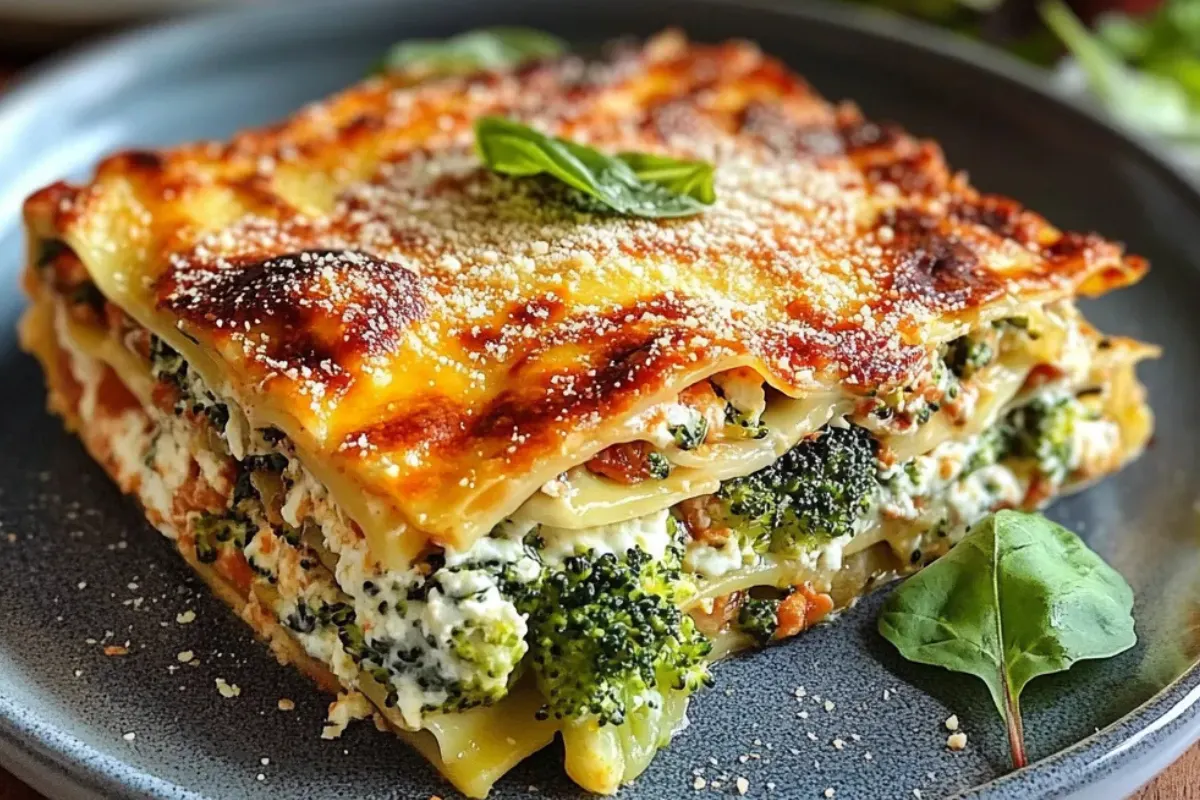When it comes to comfort food, lasagna holds a special place in everyone’s heart. But who says lasagna can’t be healthy and delicious? Lasagnes brocolis ricotta combines the creamy richness of ricotta cheese with the subtle crunch and nutrition of broccoli, creating a dish that’s as indulgent as it is good for you. This article will explore everything from its ingredients and preparation to serving ideas and common mistakes to avoid, making sure you ace this vegetarian twist on a classic recipe.
Introduction to Lasagnes Brocolis Ricotta
The Origins of Lasagnes Brocolis Ricotta
Lasagna may have Italian roots, but its variations are as global as they are diverse. Lasagnes brocolis ricotta brings a modern, healthy spin to the traditional meat-laden dish, swapping heavy ingredients for lighter, vegetarian-friendly ones. This variation has become a favorite for those seeking a guilt-free indulgence that still delivers on flavor.
Why Choose Broccoli and Ricotta in Lasagna?
Broccoli and ricotta aren’t just tasty additions; they’re nutritional powerhouses. Broccoli is packed with vitamins, fiber, and antioxidants, while ricotta offers a creamy texture with added protein and calcium. Together, they create a filling that’s both hearty and light, perfect for layering between sheets of pasta.
A Perfect Vegetarian Twist to a Classic Dish
For vegetarians or anyone looking to cut down on meat, lasagnes brocolis ricotta is a dream come true. It’s satisfying, versatile, and customizable, catering to a wide range of dietary preferences without compromising the essence of a good lasagna. Plus, it’s a fantastic way to sneak some extra greens into your meal in the most delicious way possible.

Ingredients and Nutritional Benefits
Essential Ingredients for Lasagnes Brocolis Ricotta
To create a dish as delightful as lasagnes brocolis ricotta, you’ll need a mix of fresh ingredients and pantry staples. Here’s a handy list to guide you:
| Ingredient | Quantity | Purpose |
|---|---|---|
| Lasagna sheets (regular or gluten-free) | 12 sheets | Base layers for the dish |
| Fresh broccoli florets | 3 cups | Main vegetable component |
| Ricotta cheese | 2 cups | Creamy, flavorful filling |
| Mozzarella cheese (shredded) | 1 cup | Melty topping |
| Parmesan cheese (grated) | ½ cup | Adds a savory kick |
| Garlic (minced) | 2 cloves | Enhances flavor |
| Olive oil | 2 tablespoons | For sautéing and layering |
| Salt and pepper | To taste | Balances and enriches flavors |
| Nutmeg (optional) | A pinch | Adds warmth to the ricotta mix |
| Tomato sauce (homemade or store-bought) | 2 cups | Adds moisture and richness |
Health Benefits of Broccoli in Lasagna
Broccoli is not just a filler—it’s a nutritional star! Rich in fiber, vitamins C and K, and antioxidants, it boosts your immune system while supporting healthy digestion. Its subtle flavor pairs beautifully with the creaminess of ricotta, creating a balanced taste that’s neither overwhelming nor bland.
Ricotta: The Creamy Protein Booster
Ricotta cheese is the unsung hero of vegetarian cooking. It’s low in fat yet high in protein and calcium, making it a healthier choice compared to heavier cheeses. In lasagnes brocolis ricotta, ricotta adds a light, fluffy texture to the filling while maintaining a creamy richness that complements the broccoli and tomato sauce.
Step-by-Step Recipe Guide
Preparing the Broccoli: Tips for Perfect Texture
First, steam or blanch the broccoli until it’s tender but still vibrant green. Overcooking can make it mushy, so aim for just 4–5 minutes of cooking time. Once done, chop the florets into small, bite-sized pieces to ensure they layer easily and evenly.
Creating a Flavorful Ricotta Mixture
In a mixing bowl, combine the ricotta cheese, a pinch of salt, freshly ground pepper, and a hint of nutmeg. For added depth, stir in a handful of grated Parmesan. If you’re feeling adventurous, add finely chopped spinach or fresh basil for an extra burst of flavor.
Layering Techniques for Lasagna Perfection
- Preheat your oven to 375°F (190°C) and grease a 9×13-inch baking dish with olive oil.
- Spread a thin layer of tomato sauce at the bottom of the dish.
- Lay down the first layer of lasagna sheets, ensuring there are no gaps.
- Add a generous layer of the ricotta mixture, followed by the chopped broccoli.
- Sprinkle with mozzarella and Parmesan cheeses.
- Repeat the process until you’ve used up all the ingredients, finishing with a top layer of lasagna sheets covered in tomato sauce and mozzarella.
- Cover the dish with foil and bake for 25 minutes. Then, remove the foil and bake for another 15 minutes until the cheese is bubbly and golden brown.
Allow the lasagna to cool for about 10 minutes before slicing. This resting time helps the layers set, making it easier to serve.

Variations and Customizations
Gluten-Free Options for Lasagnes Brocolis Ricotta
If you’re catering to a gluten-free crowd, worry not—there are fantastic alternatives to traditional lasagna sheets. Many brands now offer gluten-free pasta made from rice, corn, or chickpeas, which work just as well. Make sure to cook them al dente to avoid a mushy texture.
Alternatively, zucchini or eggplant slices make excellent substitutes for pasta sheets, adding even more veggies to the mix. Thinly slice the vegetables, sprinkle with salt to draw out excess moisture, and bake lightly before layering them in your dish.
Adding Extra Veggies or Proteins for Variation
Why stop at broccoli? You can incorporate other nutrient-rich vegetables like spinach, kale, or bell peppers. For a protein boost, add crumbled tofu or cooked lentils to the ricotta mixture. These ingredients blend seamlessly, enhancing the dish’s nutritional profile without overpowering the flavor.
Using Alternative Cheeses for Unique Flavors
While ricotta is the star, experimenting with different cheeses can create exciting flavor profiles. Goat cheese adds tanginess, while cream cheese brings extra richness. For a smoky twist, try smoked mozzarella or gouda. These variations can transform your lasagnes brocolis ricotta into a completely new culinary experience.
Pairing and Serving Suggestions
Ideal Side Dishes to Complement Your Lasagna
Every great main dish deserves equally delicious sides. A crisp green salad with a zesty vinaigrette pairs wonderfully with the creamy layers of lasagnes brocolis ricotta. Consider adding toasted nuts or dried cranberries for an extra crunch.
For a heartier option, serve with garlic bread or a warm focaccia. These sides soak up any leftover tomato sauce, ensuring nothing goes to waste.
Beverage Pairings for a Complete Meal
Pairing your lasagna with the right drink elevates the dining experience. A light, citrusy white wine like Sauvignon Blanc or a dry rosé complements the creamy ricotta and earthy broccoli flavors. For non-alcoholic options, try sparkling water with a splash of lemon or an herbal iced tea.
Plating Tips for a Stunning Presentation
Presentation matters! Slice the lasagna carefully, ensuring the layers remain intact. Garnish each serving with fresh basil leaves or a sprinkle of grated Parmesan. If you’re serving guests, place the slices on individual plates with a small side salad for a polished, restaurant-quality touch.
For more ideas on unique bagel pairings, you might enjoy Old Fashioned Pimento Cheese Recipe.
Common Mistakes and How to Avoid Them
Overcooking the Broccoli
One common mistake when preparing lasagnes brocolis ricotta is overcooking the broccoli. This can lead to a mushy texture that doesn’t blend well with the other ingredients. To avoid this, steam or blanch the broccoli for only 4–5 minutes, ensuring it retains its vibrant green color and slight crunch. Cooling it quickly in ice water helps lock in both the color and texture.
Balancing Ricotta and Cheese Flavors
While ricotta is a key ingredient, it’s essential to balance its mild flavor with other cheeses like mozzarella or Parmesan. Using too much ricotta can make the dish overly creamy without enough depth. To fix this, blend ricotta with a pinch of salt, pepper, and a dash of nutmeg before layering it. Adding a layer of sharp Parmesan can also elevate the overall taste.
Achieving the Right Lasagna Consistency
Nobody wants a lasagna that falls apart when served. This can happen if there’s too much liquid from the tomato sauce or improperly cooked pasta. Ensure you simmer the tomato sauce until slightly thickened and cook the pasta sheets al dente. Letting the lasagna rest for 10–15 minutes after baking allows the layers to settle and hold their shape.
FAQs
What Can I Use as a Substitute for Ricotta?
If you don’t have ricotta on hand, there are several substitutes that work well in lasagnes brocolis ricotta. Cottage cheese is an excellent option, providing a similar texture and flavor. Blended silken tofu can also be used for a vegan-friendly alternative, offering a creamy consistency without the dairy.
How Can I Make This Lasagna Vegan-Friendly?
Making a vegan version of lasagnes brocolis ricotta is simpler than you think! Swap out the ricotta for cashew or tofu-based ricotta alternatives. Replace the mozzarella and Parmesan with vegan cheese shreds. For the pasta sheets, ensure you use an egg-free variety. Vegan tomato sauces are widely available, making it easy to adapt this recipe without losing its charm.
Can I Prepare This Dish in Advance?
Yes, lasagnes brocolis ricotta is a fantastic make-ahead dish! You can assemble it up to a day before baking. Store it covered in the refrigerator, and when ready to cook, simply pop it in the oven. If baking from cold, you may need to add an extra 10–15 minutes to the cooking time.
By following these tips, you’ll master the art of preparing lasagnes brocolis ricotta with confidence.
For more creative appetizer ideas, you can discover Paloma Greenville Bread with Ricotta and Marcona Almonds.
Conclusion and Final Thoughts
Recap of the Key Steps for Success
Creating lasagnes brocolis ricotta is a rewarding experience that blends health and comfort in one delicious dish. By carefully selecting fresh broccoli, creamy ricotta, and the right balance of cheeses, you can craft a meal that satisfies both the palate and the body. Remember to avoid common mistakes like overcooking the broccoli or using too much liquid, ensuring your lasagna has the perfect consistency.
Encouragement to Try New Variations
The beauty of lasagnes brocolis ricotta lies in its versatility. Don’t hesitate to experiment with gluten-free pasta, alternative cheeses, or additional vegetables. Each variation offers a unique twist, keeping the dish exciting and suitable for different preferences.
Invitation for Feedback and Sharing
We’d love to hear about your experience with lasagnes brocolis ricotta! Did you add a special ingredient or try a unique presentation? Share your tips and photos with us, and let’s inspire more people to try this delightful recipe.

